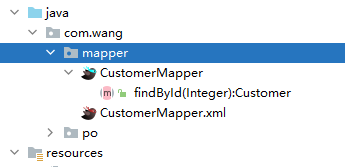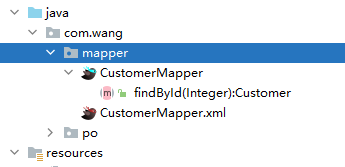spring-mybatis整合
1.环境配置
1.1导入依赖:
sringAop
<!--Spring 所需Jar包 -->
<!--AOP所需依赖-->
<dependency>
<groupId>aopalliance</groupId>
<artifactId>aopalliance</artifactId>
<version>1.0</version>
</dependency>
<dependency>
<groupId>org.aspectj</groupId>
<artifactId>aspectjweaver</artifactId>
<version>1.9.7</version>
</dependency>
<dependency>
<groupId>org.springframework</groupId>
<artifactId>spring-aop</artifactId>
<version>5.2.12.RELEASE</version>
</dependency>
<dependency>
<groupId>org.springframework</groupId>
<artifactId>spring-aspects</artifactId>
<version>5.2.12.RELEASE</version>
</dependency>
spring核心
<dependency>
<groupId>org.springframework</groupId>
<artifactId>spring-beans</artifactId>
<version>5.2.12.RELEASE</version>
</dependency>
<dependency>
<groupId>org.springframework</groupId>
<artifactId>spring-context</artifactId>
<version>5.2.12.RELEASE</version>
</dependency>
<dependency>
<groupId>org.springframework</groupId>
<artifactId>spring-core</artifactId>
<version>5.2.12.RELEASE</version>
</dependency>
<dependency>
<groupId>org.springframework</groupId>
<artifactId>spring-expression</artifactId>
<version>5.2.12.RELEASE</version>
</dependency>
springJdbc
<!-- SpringJDBC依赖-->
<dependency>
<groupId>org.springframework</groupId>
<artifactId>spring-jdbc</artifactId>
<version>5.2.12.RELEASE</version>
</dependency>
springTx
<!-- Spring 事务管理依赖-->
<dependency>
<groupId>org.springframework</groupId>
<artifactId>spring-tx</artifactId>
<version>5.2.12.RELEASE</version>
</dependency>
springTest
<!-- spring test 依赖 ,没有它junit无法加载Spring 上下文-->
<dependency>
<groupId>org.springframework</groupId>
<artifactId>spring-test</artifactId>
<version>5.2.12.RELEASE</version>
</dependency>
mybatis
<!--mybatis 核心jar-->
<dependency>
<groupId>org.mybatis</groupId>
<artifactId>mybatis</artifactId>
<version>3.5.5</version>
</dependency>
整合中间件
<!--整合中间件 mybatis写的-->
<!-- https://mvnrepository.com/artifact/org.mybatis/mybatis-spring -->
<dependency>
<groupId>org.mybatis</groupId>
<artifactId>mybatis-spring</artifactId>
<version>1.3.2</version>
</dependency>
数据库驱动
<!--数据库驱动-->
<dependency>
<groupId>mysql</groupId>
<artifactId>mysql-connector-java</artifactId>
<version>8.0.27</version>
</dependency>
数据源
<!--数据源-->
<dependency>
<groupId>org.apache.commons</groupId>
<artifactId>commons-dbcp2</artifactId>
<exclusions>
<exclusion>
<groupId>commons-logging</groupId>
<artifactId>commons-logging</artifactId>
</exclusion>
</exclusions>
<version>2.8.0</version>
</dependency>
<dependency>
<groupId>org.apache.commons</groupId>
<artifactId>commons-pool2</artifactId>
<version>2.8.1</version>
</dependency>
日志
<!--日志-->
<dependency>
<groupId>org.apache.logging.log4j</groupId>
<artifactId>log4j-slf4j-impl</artifactId>
<version>2.9.1</version>
</dependency>
辅助工具
<!--辅助工具-->
<dependency>
<groupId>org.projectlombok</groupId>
<artifactId>lombok</artifactId>
<version>1.18.22</version>
</dependency>
测试
<!-- 测试-->
<dependency>
<groupId>junit</groupId>
<artifactId>junit</artifactId>
<version>4.13.1</version>
<scope>test</scope>
</dependency>
mvn配置
<!--配置加载XML -->
<build>
<resources>
<resource>
<directory>src/main/java</directory>
<includes>
<include>**/*.xml</include>
</includes>
</resource>
</resources>
</build>
1.2 数据库配置
- com.mysql.jdbc.Driver
- mysql5及以下版本驱动
- com.mysql.cj.jdbc.Driver
- mysql6及以上版本驱动
- url 中必须配置时区serverTimeZone=GMT%2B8
jdbc.driver= com.mysql.cj.jdbc.Driver
jdbc.url= jdbc:mysql://xxx.xxx.xxx.xxx:3306/mybatis?characterEncoding=utf8&useSSL=false&serverTimezone=GMT%2B8&allowPublicKeyRetrieval=true
jdbc.username= root
jdbc.password= xxxxxx
jdbc.maxTotal= 30
jdbc.maxIdle= 20
jdbc.initialSize= 5
1.3 applicationContext.xml
<?xml version="1.0" encoding="UTF-8"?>
<beans
xmlns:tx="http://www.springframework.org/schema/tx"
xmlns="http://www.springframework.org/schema/beans"
xmlns:xsi="http://www.w3.org/2001/XMLSchema-instance"
xmlns:context="http://www.springframework.org/schema/context"
xsi:schemaLocation="http://www.springframework.org/schema/beans
http://www.springframework.org/schema/beans/spring-beans.xsd
http://www.springframework.org/schema/context
http://www.springframework.org/schema/context/spring-context-3.0.xsd
http://www.springframework.org/schema/tx
http://www.springframework.org/schema/tx/spring-tx.xsd
">
<!-- 读取db.yml 文件-->
<context:property-placeholder location="db.properties"/>
<!-- 配置数据源 -->
<bean id="dataSource" class="org.apache.commons.dbcp2.BasicDataSource">
<property name="driverClassName" value="${jdbc.driver}"/>
<property name="url" value="${jdbc.url}"/>
<property name="username" value="${jdbc.username}"/>
<property name="password" value="${jdbc.password}"/>
<!--最大连接数-->
<property name="maxTotal" value="${jdbc.maxTotal}"/>
<!--最大空闲连接数-->
<property name="maxIdle" value="${jdbc.maxIdle}"/>
<!--初始化连接数-->
<property name="initialSize" value="${jdbc.initialSize}"/>
</bean>
<!--事务管理器,依赖于数据源-->
<bean id="transactionManager" class="org.springframework.jdbc.datasource.DataSourceTransactionManager">
<property name="dataSource" ref="dataSource"/>
</bean>
<!-- 开启事务注解-->
<tx:annotation-driven transaction-manager="transactionManager" />
<!-- 配置mybatis工厂bean -->
<bean id="sqlSessionFactory" class="org.mybatis.spring.SqlSessionFactoryBean">
<!--数据源-->
<property name="dataSource" ref="dataSource"/>
<!--配置文件路径-->
<property name="configLocation" value="mybatis-config.xml"/>
</bean>
</beans>
1.4 mybatis-config.xml
<?xml version="1.0" encoding="UTF-8" ?>
<!DOCTYPE configuration
PUBLIC "-//mybatis.org//DTD Config 3.0//EN"
"http://mybatis.org/dtd/mybatis-3-config.dtd">
<configuration>
<!--为包内类全限定名配置别名-->
<typeAliases>
<package name="com.wang.po"/>
</typeAliases>
<mappers>
</mappers>
</configuration>
1.5 log4j2.xml
<?xml version="1.0" encoding="UTF-8"?>
<configuration status="OFF">
<!--输出目的地配置-->
<appenders>
<Console name="Console" target="SYSTEM_OUT">
<!-- %d{格式 yyyy-MM-dd HH:mm:ss,SSS} 时间
%c 全限定类名
%highlight{%d-5level} 输出打印优先级{颜色类型}
%style{[%t]} 对线程名添加风格{bright,magenta}
%L 行数
%M 调用logger 的方法名
-->
<PatternLayout pattern="%d{HH:mm:ss} %highlight{%-5level}{ERROR=Bright RED, WARN=Bright Yellow, INFO=Bright Green, DEBUG=Bright Cyan, TRACE=Bright White} %style{[%t]}{bright,magenta} %style{%c{1.}.%M(%L)}{cyan}->>> %msg%n"/>
</Console>
</appenders>
<loggers>
<root level="DEBUG">
<appender-ref ref="Console"/>
</root>
</loggers>
</configuration>
2.整合方式
2.1 传统Dao开发整合
整合的统一思想:
需要向持久层注入SqlSessionFactory,因为在Spring 种SqlSessionFactory 默认创建是单例的,所以符合SqlSessionFactory的操作特点(数据库的映射,线程安全)
而持久层的方法体内则需要创建SqlSession 对象,在每一个方法体中都需要创建,因为SqlSession 是非线程安全的,其中包含了所有的SQL信息,唯一标识SQL的就是配置的id
基于传统Dao方式开发有两种情况:
- 继承SqlSessionDaoSupport:
- 是一个抽象支持类,继承自DaoSupport,主要作为Dao的基类来使用,可以通过SqlSessionDaoSupport 类的getSqlSession方法来获取所需的SqlSession
- SqlSessionTemplate
- mybatis-spring 的核心类,负责管理Mybatis的SqlSession,调用mybatis 的SQL方法,调用SQL方法时,会保证使用的SqlSession 与当前的Spring 事务时相关的,还管理SqlSession 的生命周期,包含必要的关闭、提交和回滚操作
使用SqlSessionDaoSupport 更加的方便,但实际上底层也是通过SqlSessionTemplate 提高的SqlSession 对象
因为SqlSessionDaoSupport 需要SqlSessionFactory对象,所以在使用的时候需要将SqlSessionFactory 对象注入其中
定义接口:
public interface CustomerDao {
/**
* @param id 用户id
* @return 用户
*/
public Customer findById(Integer id);
}
编写实现类:
继承SqlSessionDaoSupport抽象类,注入SqlSessionFactory 对象,并通过getSqlSession方法获取SqlSession
public class CustomerDaoImpl extends SqlSessionDaoSupport implements CustomerDao {
@Override
public Customer findById(Integer id) {
/*
继承SqlSessionDaoSupport 类
使用时,Spring 会给他注入一个SqlSessionFactory 或SqlSessionTemplate 对象
这样就能通过getSqlSession 来获取SqlSession对象
*/
return this.getSqlSession().selectOne("findById",id);
}
}
因为是在SqlSessionDaoSupport 类中SqlSessionFactory 对象是通过setter 方法注入的,所以可以在applicationContext.xml 中直接注入:
<!--实例化-->
<bean id="customerDao" class="com.wang.dao.impl.CustomerDaoImpl">
<!-- 注入中间件支持的SqlSessionDaoSupport 所需的 sqlSessionFactory -->
<property name="sqlSessionFactory" ref="sqlSessionFactory"/>
</bean>
测试:
这里需要注意的是
-
Junit 和Spring 也是需要整合的,不能简单的通过编写test直接运行,这样并不会加载Spring 的容器,而是仅运行了一个测试类
-
首先需要导入Spring-test dependency
-
<!-- spring test 依赖 ,没有它junit无法加载Spring 上下文--> <dependency> <groupId>org.springframework</groupId> <artifactId>spring-test</artifactId> <version>5.2.12.RELEASE</version> </dependency>
-
-
其次需要在测试类上写明启动环境以及加载的配置文件
@RunWith(SpringJUnit4ClassRunner.class) @ContextConfiguration(locations = { "classpath:applicationContext.xml" }) -
完整代码:
@RunWith(SpringJUnit4ClassRunner.class) @ContextConfiguration(locations = { "classpath:applicationContext.xml" }) @Slf4j public class CustomerDaoTest { @Autowired CustomerDao customerDao; @Test public void test1(){ System.out.println(customerDao.findById(1)); } }
2.2 Mapper接口方式开发整合
对于上面的通过SqlSession 进行开发会很繁琐,无形中增加了工作负担,所以Mybatis-spring 提供了根据Mapper 接口动态代理生成Mapper 对象的类——MapperFactoryBean,依赖于:
- mapperInterface:用于指定接口
- sqlSessionFactory:用于指定SqlSessionFactory 也可以指定SqlSessionTemplate ,如果同时指定只会启动SqlSessionFactory
这种方式的本质是通过程序员编写Mapper 接口,由框架通过定义创建接口的动态代理对象,这个代理对象的方法体等同于上面Dao接口的实现类方法,也就是获取SqlSession 并且通过sqlSession 根据id调用方法,如果按照以下规范去书写,可以在配置文件(mybatis-config.xml)中不引入映射文件(xxxMapper.xml),框架会直接扫描进行绑定:
Mapper 接口和xml映射文件名称一致:CustomerMapper—CustomerMapper.xml
mapper 和xml 必须需要在一个包内
xml 中的namspce 和Mapper 接口的类路径一致:
<mapper namespace="com.wang.dao.CustomerMapper">Mapper 接口中的方法名和xml 中的每个执行语句的id 一致
Mapper 接口中的输入参数和xml中的parameterType 一致
Mapper 接口中的输出参数和xml 中resultType 一致
四种Mapper 的配置方式:
- 面向xml文件:
- 需要将每个xml都进行注册
- 面向接口:
- 需要将每个接口进行注册
- 面向包:
- 需要将包的每个接口都注册,且接口名要与xml名一致
- 不注册:
- xml必须和接口在一个包下
定义接口:
public interface CustomerMapper {
/**
* @param id 用户id
* @return 用户
*/
public Customer findById(Integer id);
}
定义xml:
xml 的namespace需要是对应接口的全限定路径:
<?xml version="1.0" encoding="UTF-8" ?>
<!DOCTYPE mapper
PUBLIC "-//mybatis.org//DTD Mapper 3.0//EN"
"http://mybatis.org/dtd/mybatis-3-mapper.dtd">
<mapper namespace="com.wang.mapper.CustomerMapper">
<select id="findById" parameterType="Integer"
resultType="com.wang.po.Customer">
select * from t_customer where id = #{id}
</select>
</mapper>
注册/不注册:
<!--mapper 注册 -->
<mappers>
<!--<mapper resource="com/wang/mapper/CustomerMapper.xml"/>-->
<!-- <package name="com.wang.mapper"/>-->
<!-- <mapper class="com.wang.dao.CustomerMapper"/>-->
</mappers>
测试:
@RunWith(SpringJUnit4ClassRunner.class)
@ContextConfiguration(locations = { "classpath:applicationContext.xml" })
@Slf4j
public class CustomerDaoTest {
@Autowired
CustomerMapper customerMapper;
@Test
public void test1(){
System.out.println(customerMapper.findById(1));
}
}
2.3 MapperScannerConfigurer
所有的mapper 接口不需要一个一个的在applicationContext中进行注册,myabtis-spring 团队提供了一种自动扫描的形式来配置,采用mybatisScannerConfigurer 类:
需要配置的属性:
- basePackage:指定映射接口文件的包路径,当扫描多个包时可以使用分号或逗号作为分隔符,指定包路径后,扫描该报及其子包中的所有文件
- annotationClass:指定要扫描的注解名称,只有被注解标识的类才会被配置为映射器
- sqlSessionFactoryBeanName:指定在spring中定义的SqlSessionFactory的Bean名称
- sqlSessionTemplateBeanName:指定在Spring 中定义的SqlSessionTemplate 的Bean名称,如果定义次属性,sqlSessionFactoryBeanName 将不起作用
- narkerInterface:创建映射器的接口
<!--接口映射器-->
<bean class="org.mybatis.spring.mapper.MapperScannerConfigurer">
<property name="basePackage" value="com.wang.mapper"/>
<!-- <property name="annotationClass" value="org.apache.ibatis.annotations.Mapper"/>-->
</bean>
这样所有的mapper接口都会注册到IOC容器中,但是映射xml文件还需要继续进行配置。
也可以通过@Mapper 注解到interface 上面,通过配置annotationClass来进行扫描
2.4 整合事务
在Mybatis 中事务是交由spring 进行管理的,而事务的处理主要是通过@Transactional 注解进行处理,而处理的位置则是service 层,及在service 层调用的方法中若爆出异常则会进行事务回滚,事务也就影响不到数据库。
开启事务注解
applicationContext.xml
<!-- 开启事务注解-->
<tx:annotation-driven transaction-manager="transactionManager" />
开启spring注解扫描
<!-- 开启spring的注解扫描-->
<context:component-scan base-package="com.wang"/>
service层

@Transactional 注解即可以注解到方法上,则本方法开启事务管理,也可以注解到类或接口上,则类和接口里的方法都开启事务管理# spring-mybatis整合
1.环境配置
1.1导入依赖:
sringAop
<!--Spring 所需Jar包 -->
<!--AOP所需依赖-->
<dependency>
<groupId>aopalliance</groupId>
<artifactId>aopalliance</artifactId>
<version>1.0</version>
</dependency>
<dependency>
<groupId>org.aspectj</groupId>
<artifactId>aspectjweaver</artifactId>
<version>1.9.7</version>
</dependency>
<dependency>
<groupId>org.springframework</groupId>
<artifactId>spring-aop</artifactId>
<version>5.2.12.RELEASE</version>
</dependency>
<dependency>
<groupId>org.springframework</groupId>
<artifactId>spring-aspects</artifactId>
<version>5.2.12.RELEASE</version>
</dependency>
spring核心
<dependency>
<groupId>org.springframework</groupId>
<artifactId>spring-beans</artifactId>
<version>5.2.12.RELEASE</version>
</dependency>
<dependency>
<groupId>org.springframework</groupId>
<artifactId>spring-context</artifactId>
<version>5.2.12.RELEASE</version>
</dependency>
<dependency>
<groupId>org.springframework</groupId>
<artifactId>spring-core</artifactId>
<version>5.2.12.RELEASE</version>
</dependency>
<dependency>
<groupId>org.springframework</groupId>
<artifactId>spring-expression</artifactId>
<version>5.2.12.RELEASE</version>
</dependency>
springJdbc
<!-- SpringJDBC依赖-->
<dependency>
<groupId>org.springframework</groupId>
<artifactId>spring-jdbc</artifactId>
<version>5.2.12.RELEASE</version>
</dependency>
springTx
<!-- Spring 事务管理依赖-->
<dependency>
<groupId>org.springframework</groupId>
<artifactId>spring-tx</artifactId>
<version>5.2.12.RELEASE</version>
</dependency>
springTest
<!-- spring test 依赖 ,没有它junit无法加载Spring 上下文-->
<dependency>
<groupId>org.springframework</groupId>
<artifactId>spring-test</artifactId>
<version>5.2.12.RELEASE</version>
</dependency>
mybatis
<!--mybatis 核心jar-->
<dependency>
<groupId>org.mybatis</groupId>
<artifactId>mybatis</artifactId>
<version>3.5.5</version>
</dependency>
整合中间件
<!--整合中间件 mybatis写的-->
<!-- https://mvnrepository.com/artifact/org.mybatis/mybatis-spring -->
<dependency>
<groupId>org.mybatis</groupId>
<artifactId>mybatis-spring</artifactId>
<version>1.3.2</version>
</dependency>
数据库驱动
<!--数据库驱动-->
<dependency>
<groupId>mysql</groupId>
<artifactId>mysql-connector-java</artifactId>
<version>8.0.27</version>
</dependency>
数据源
<!--数据源-->
<dependency>
<groupId>org.apache.commons</groupId>
<artifactId>commons-dbcp2</artifactId>
<exclusions>
<exclusion>
<groupId>commons-logging</groupId>
<artifactId>commons-logging</artifactId>
</exclusion>
</exclusions>
<version>2.8.0</version>
</dependency>
<dependency>
<groupId>org.apache.commons</groupId>
<artifactId>commons-pool2</artifactId>
<version>2.8.1</version>
</dependency>
日志
<!--日志-->
<dependency>
<groupId>org.apache.logging.log4j</groupId>
<artifactId>log4j-slf4j-impl</artifactId>
<version>2.9.1</version>
</dependency>
辅助工具
<!--辅助工具-->
<dependency>
<groupId>org.projectlombok</groupId>
<artifactId>lombok</artifactId>
<version>1.18.22</version>
</dependency>
测试
<!-- 测试-->
<dependency>
<groupId>junit</groupId>
<artifactId>junit</artifactId>
<version>4.13.1</version>
<scope>test</scope>
</dependency>
mvn配置
<!--配置加载XML -->
<build>
<resources>
<resource>
<directory>src/main/java</directory>
<includes>
<include>**/*.xml</include>
</includes>
</resource>
</resources>
</build>
1.2 数据库配置
- com.mysql.jdbc.Driver
- mysql5及以下版本驱动
- com.mysql.cj.jdbc.Driver
- mysql6及以上版本驱动
- url 中必须配置时区serverTimeZone=GMT%2B8
jdbc.driver= com.mysql.cj.jdbc.Driver
jdbc.url= jdbc:mysql://xxx.xxx.xxx.xxx:3306/mybatis?characterEncoding=utf8&useSSL=false&serverTimezone=GMT%2B8&allowPublicKeyRetrieval=true
jdbc.username= root
jdbc.password= xxxxxx
jdbc.maxTotal= 30
jdbc.maxIdle= 20
jdbc.initialSize= 5
1.3 applicationContext.xml
<?xml version="1.0" encoding="UTF-8"?>
<beans
xmlns:tx="http://www.springframework.org/schema/tx"
xmlns="http://www.springframework.org/schema/beans"
xmlns:xsi="http://www.w3.org/2001/XMLSchema-instance"
xmlns:context="http://www.springframework.org/schema/context"
xsi:schemaLocation="http://www.springframework.org/schema/beans
http://www.springframework.org/schema/beans/spring-beans.xsd
http://www.springframework.org/schema/context
http://www.springframework.org/schema/context/spring-context-3.0.xsd
http://www.springframework.org/schema/tx
http://www.springframework.org/schema/tx/spring-tx.xsd
">
<!-- 读取db.yml 文件-->
<context:property-placeholder location="db.properties"/>
<!-- 配置数据源 -->
<bean id="dataSource" class="org.apache.commons.dbcp2.BasicDataSource">
<property name="driverClassName" value="${jdbc.driver}"/>
<property name="url" value="${jdbc.url}"/>
<property name="username" value="${jdbc.username}"/>
<property name="password" value="${jdbc.password}"/>
<!--最大连接数-->
<property name="maxTotal" value="${jdbc.maxTotal}"/>
<!--最大空闲连接数-->
<property name="maxIdle" value="${jdbc.maxIdle}"/>
<!--初始化连接数-->
<property name="initialSize" value="${jdbc.initialSize}"/>
</bean>
<!--事务管理器,依赖于数据源-->
<bean id="transactionManager" class="org.springframework.jdbc.datasource.DataSourceTransactionManager">
<property name="dataSource" ref="dataSource"/>
</bean>
<!-- 开启事务注解-->
<tx:annotation-driven transaction-manager="transactionManager" />
<!-- 配置mybatis工厂bean -->
<bean id="sqlSessionFactory" class="org.mybatis.spring.SqlSessionFactoryBean">
<!--数据源-->
<property name="dataSource" ref="dataSource"/>
<!--配置文件路径-->
<property name="configLocation" value="mybatis-config.xml"/>
</bean>
</beans>
1.4 mybatis-config.xml
<?xml version="1.0" encoding="UTF-8" ?>
<!DOCTYPE configuration
PUBLIC "-//mybatis.org//DTD Config 3.0//EN"
"http://mybatis.org/dtd/mybatis-3-config.dtd">
<configuration>
<!--为包内类全限定名配置别名-->
<typeAliases>
<package name="com.wang.po"/>
</typeAliases>
<mappers>
</mappers>
</configuration>
1.5 log4j2.xml
<?xml version="1.0" encoding="UTF-8"?>
<configuration status="OFF">
<!--输出目的地配置-->
<appenders>
<Console name="Console" target="SYSTEM_OUT">
<!-- %d{格式 yyyy-MM-dd HH:mm:ss,SSS} 时间
%c 全限定类名
%highlight{%d-5level} 输出打印优先级{颜色类型}
%style{[%t]} 对线程名添加风格{bright,magenta}
%L 行数
%M 调用logger 的方法名
-->
<PatternLayout pattern="%d{HH:mm:ss} %highlight{%-5level}{ERROR=Bright RED, WARN=Bright Yellow, INFO=Bright Green, DEBUG=Bright Cyan, TRACE=Bright White} %style{[%t]}{bright,magenta} %style{%c{1.}.%M(%L)}{cyan}->>> %msg%n"/>
</Console>
</appenders>
<loggers>
<root level="DEBUG">
<appender-ref ref="Console"/>
</root>
</loggers>
</configuration>
2.整合方式
2.1 传统Dao开发整合
整合的统一思想:
需要向持久层注入SqlSessionFactory,因为在Spring 种SqlSessionFactory 默认创建是单例的,所以符合SqlSessionFactory的操作特点(数据库的映射,线程安全)
而持久层的方法体内则需要创建SqlSession 对象,在每一个方法体中都需要创建,因为SqlSession 是非线程安全的,其中包含了所有的SQL信息,唯一标识SQL的就是配置的id
基于传统Dao方式开发有两种情况:
- 继承SqlSessionDaoSupport:
- 是一个抽象支持类,继承自DaoSupport,主要作为Dao的基类来使用,可以通过SqlSessionDaoSupport 类的getSqlSession方法来获取所需的SqlSession
- SqlSessionTemplate
- mybatis-spring 的核心类,负责管理Mybatis的SqlSession,调用mybatis 的SQL方法,调用SQL方法时,会保证使用的SqlSession 与当前的Spring 事务时相关的,还管理SqlSession 的生命周期,包含必要的关闭、提交和回滚操作
使用SqlSessionDaoSupport 更加的方便,但实际上底层也是通过SqlSessionTemplate 提高的SqlSession 对象
因为SqlSessionDaoSupport 需要SqlSessionFactory对象,所以在使用的时候需要将SqlSessionFactory 对象注入其中
定义接口:
public interface CustomerDao {
/**
* @param id 用户id
* @return 用户
*/
public Customer findById(Integer id);
}
编写实现类:
继承SqlSessionDaoSupport抽象类,注入SqlSessionFactory 对象,并通过getSqlSession方法获取SqlSession
public class CustomerDaoImpl extends SqlSessionDaoSupport implements CustomerDao {
@Override
public Customer findById(Integer id) {
/*
继承SqlSessionDaoSupport 类
使用时,Spring 会给他注入一个SqlSessionFactory 或SqlSessionTemplate 对象
这样就能通过getSqlSession 来获取SqlSession对象
*/
return this.getSqlSession().selectOne("findById",id);
}
}
因为是在SqlSessionDaoSupport 类中SqlSessionFactory 对象是通过setter 方法注入的,所以可以在applicationContext.xml 中直接注入:
<!--实例化-->
<bean id="customerDao" class="com.wang.dao.impl.CustomerDaoImpl">
<!-- 注入中间件支持的SqlSessionDaoSupport 所需的 sqlSessionFactory -->
<property name="sqlSessionFactory" ref="sqlSessionFactory"/>
</bean>
测试:
这里需要注意的是
-
Junit 和Spring 也是需要整合的,不能简单的通过编写test直接运行,这样并不会加载Spring 的容器,而是仅运行了一个测试类
-
首先需要导入Spring-test dependency
-
<!-- spring test 依赖 ,没有它junit无法加载Spring 上下文--> <dependency> <groupId>org.springframework</groupId> <artifactId>spring-test</artifactId> <version>5.2.12.RELEASE</version> </dependency>
-
-
其次需要在测试类上写明启动环境以及加载的配置文件
@RunWith(SpringJUnit4ClassRunner.class) @ContextConfiguration(locations = { "classpath:applicationContext.xml" }) -
完整代码:
@RunWith(SpringJUnit4ClassRunner.class) @ContextConfiguration(locations = { "classpath:applicationContext.xml" }) @Slf4j public class CustomerDaoTest { @Autowired CustomerDao customerDao; @Test public void test1(){ System.out.println(customerDao.findById(1)); } }
2.2 Mapper接口方式开发整合
对于上面的通过SqlSession 进行开发会很繁琐,无形中增加了工作负担,所以Mybatis-spring 提供了根据Mapper 接口动态代理生成Mapper 对象的类——MapperFactoryBean,依赖于:
- mapperInterface:用于指定接口
- sqlSessionFactory:用于指定SqlSessionFactory 也可以指定SqlSessionTemplate ,如果同时指定只会启动SqlSessionFactory
这种方式的本质是通过程序员编写Mapper 接口,由框架通过定义创建接口的动态代理对象,这个代理对象的方法体等同于上面Dao接口的实现类方法,也就是获取SqlSession 并且通过sqlSession 根据id调用方法,如果按照以下规范去书写,可以在配置文件(mybatis-config.xml)中不引入映射文件(xxxMapper.xml),框架会直接扫描进行绑定:
Mapper 接口和xml映射文件名称一致:CustomerMapper—CustomerMapper.xml
mapper 和xml 必须需要在一个包内
xml 中的namspce 和Mapper 接口的类路径一致:
<mapper namespace="com.wang.dao.CustomerMapper">Mapper 接口中的方法名和xml 中的每个执行语句的id 一致
Mapper 接口中的输入参数和xml中的parameterType 一致
Mapper 接口中的输出参数和xml 中resultType 一致
四种Mapper 的配置方式:
- 面向xml文件:
- 需要将每个xml都进行注册
- 面向接口:
- 需要将每个接口进行注册
- 面向包:
- 需要将包的每个接口都注册,且接口名要与xml名一致
- 不注册:
- xml必须和接口在一个包下
定义接口:
public interface CustomerMapper {
/**
* @param id 用户id
* @return 用户
*/
public Customer findById(Integer id);
}
定义xml:
xml 的namespace需要是对应接口的全限定路径:
<?xml version="1.0" encoding="UTF-8" ?>
<!DOCTYPE mapper
PUBLIC "-//mybatis.org//DTD Mapper 3.0//EN"
"http://mybatis.org/dtd/mybatis-3-mapper.dtd">
<mapper namespace="com.wang.mapper.CustomerMapper">
<select id="findById" parameterType="Integer"
resultType="com.wang.po.Customer">
select * from t_customer where id = #{id}
</select>
</mapper>
注册/不注册:
<!--mapper 注册 -->
<mappers>
<!--<mapper resource="com/wang/mapper/CustomerMapper.xml"/>-->
<!-- <package name="com.wang.mapper"/>-->
<!-- <mapper class="com.wang.dao.CustomerMapper"/>-->
</mappers>
测试:
@RunWith(SpringJUnit4ClassRunner.class)
@ContextConfiguration(locations = { "classpath:applicationContext.xml" })
@Slf4j
public class CustomerDaoTest {
@Autowired
CustomerMapper customerMapper;
@Test
public void test1(){
System.out.println(customerMapper.findById(1));
}
}
2.3 MapperScannerConfigurer
所有的mapper 接口不需要一个一个的在applicationContext中进行注册,myabtis-spring 团队提供了一种自动扫描的形式来配置,采用mybatisScannerConfigurer 类:
需要配置的属性:
- basePackage:指定映射接口文件的包路径,当扫描多个包时可以使用分号或逗号作为分隔符,指定包路径后,扫描该报及其子包中的所有文件
- annotationClass:指定要扫描的注解名称,只有被注解标识的类才会被配置为映射器
- sqlSessionFactoryBeanName:指定在spring中定义的SqlSessionFactory的Bean名称
- sqlSessionTemplateBeanName:指定在Spring 中定义的SqlSessionTemplate 的Bean名称,如果定义次属性,sqlSessionFactoryBeanName 将不起作用
- narkerInterface:创建映射器的接口
<!--接口映射器-->
<bean class="org.mybatis.spring.mapper.MapperScannerConfigurer">
<property name="basePackage" value="com.wang.mapper"/>
<!-- <property name="annotationClass" value="org.apache.ibatis.annotations.Mapper"/>-->
</bean>
这样所有的mapper接口都会注册到IOC容器中,但是映射xml文件还需要继续进行配置。
也可以通过@Mapper 注解到interface 上面,通过配置annotationClass来进行扫描
2.4 整合事务
在Mybatis 中事务是交由spring 进行管理的,而事务的处理主要是通过@Transactional 注解进行处理,而处理的位置则是service 层,及在service 层调用的方法中若爆出异常则会进行事务回滚,事务也就影响不到数据库。
开启事务注解
applicationContext.xml
<!-- 开启事务注解-->
<tx:annotation-driven transaction-manager="transactionManager" />
开启spring注解扫描
<!-- 开启spring的注解扫描-->
<context:component-scan base-package="com.wang"/>
service层

@Transactional 注解即可以注解到方法上,则本方法开启事务管理,也可以注解到类或接口上,则类和接口里的方法都开启事务管理


































 5778
5778











 被折叠的 条评论
为什么被折叠?
被折叠的 条评论
为什么被折叠?








